Assessment of Fit
This section contains a collection of formulas used in computing
indices to assess the
goodness of fit by
PROC CALIS. The following notation is used:
- N for the sample size
- n for the number of manifest variables
- t for the number of parameters to estimate
-

- df for the degrees of freedom
-
 for the t vector of optimal parameter
estimates
for the t vector of optimal parameter
estimates
- S = (sij) for the n ×n input COV, CORR,
UCOV, or UCORR matrix
-
 for the predicted model matrix
for the predicted model matrix
- W for the weight matrix (W = I for ULS, W = S
for default GLS, and W = C for ML estimates)
- U for the n2 ×n2 asymptotic covariance matrix of sample covariances
-
 for the cumulative distribution function
of the noncentral chi-squared distribution with noncentrality parameter
for the cumulative distribution function
of the noncentral chi-squared distribution with noncentrality parameter 
The following notation is for indices that allow testing nested
models by a  difference test:
difference test:
- f0 for the function value of the independence model
- df0 for the degrees of freedom of the independence model
- fmin = F for the function value of the fitted model
- dfmin = df for the degrees of freedom of the fitted model
The degrees of freedom dfmin and the number of parameters t are
adjusted automatically when there are active constraints in the analysis.
The computation of many fit statistics and indices are affected. You
can turn off the automatic adjustment using the NOADJDF option. See
the section "Counting the Degrees of Freedom" for more information.
Residuals
PROC CALIS computes four types of residuals and writes them to the
OUTSTAT= data set:
- Raw Residuals
-
Res = S- C, Resij = sij - cij
The raw residuals are displayed whenever the PALL,
the PRINT, or the RESIDUAL option is specified.
- Variance Standardized Residuals

The variance standardized residuals are displayed when you specify
- the PALL, the PRINT, or the RESIDUAL option
and METHOD=NONE,
METHOD=ULS, or METHOD=DWLS
- RESIDUAL=VARSTAND
The variance standardized residuals are equal to those
computed by the EQS 3 program (Bentler 1989).
- Asymptotically Standardized Residuals


The matrix J is the n2 ×t Jacobian matrix
 , and
, and  is the
t ×t asymptotic covariance matrix of parameter
estimates (the inverse of the information matrix).
Asymptotically standardized residuals are displayed when
one of the following conditions is met:
is the
t ×t asymptotic covariance matrix of parameter
estimates (the inverse of the information matrix).
Asymptotically standardized residuals are displayed when
one of the following conditions is met:
- The PALL, the PRINT, or the RESIDUAL option
is specified, and METHOD=ML,
METHOD=GLS, or METHOD=WLS, and the expensive
information and Jacobian matrices are computed
for some other reason.
- RESIDUAL= ASYSTAND is specified.
The asymptotically standardized residuals are equal to those
computed by the LISREL 7 program (J reskog and
S
reskog and
S rbom 1988) except for the denominator NM in
the definition of matrix U.
rbom 1988) except for the denominator NM in
the definition of matrix U.
- Normalized Residuals

where the diagonal elements uij,ij of the n2 ×n2
asymptotic covariance matrix U of sample covariances are
defined for the following methods.
- GLS as

- ML as

- WLS as uij,ij = wij,ij
Normalized residuals are displayed when one of the following
conditions is met:
- The PALL, the PRINT, or the RESIDUAL option
is specified, and METHOD=ML,
METHOD=GLS, or METHOD=WLS, and the expensive
information and Jacobian matrices are not
computed for some other reason.
- RESIDUAL=NORM is specified.
The normalized residuals are equal to those
computed by the LISREL VI program
(J reskog and S
reskog and S rbom 1985) except for the
definition of the denominator NM in matrix U.
rbom 1985) except for the
definition of the denominator NM in matrix U.
For estimation methods that are
not BGLS estimation methods (Browne 1982, 1984), such as
METHOD=NONE, METHOD=ULS, or METHOD=DWLS, the assumption of an asymptotic
covariance matrix U of sample covariances does not seem to
be appropriate. In this case, the normalized residuals should be
replaced by the more relaxed variance standardized residuals.
Computation of asymptotically standardized residuals requires
computing the Jacobian and information matrices.
This is computationally very expensive and is done only if the
Jacobian matrix has to be computed for some other reason, that is,
if at least one of the following items is true:
- The default, PRINT, or PALL displayed output is
requested, and neither the NOMOD nor NOSTDERR option is
specified.
- Either the MODIFICATION (included in PALL), PCOVES, or
STDERR (included in default, PRINT, and PALL output) option
is requested
or RESIDUAL=ASYSTAND is specified.
- The LEVMAR or NEWRAP optimization technique
is used.
- An OUTRAM= data set is specified without using the
NOSTDERR option.
- An OUTEST= data set is specified without using the
NOSTDERR option.
Since normalized residuals use an overestimate of the
asymptotic covariance matrix of residuals (the diagonal of U),
the normalized residuals cannot be larger than the
asymptotically standardized residuals (which use the
diagonal of  ).
).
Together with the residual matrices, the values of the average
residual, the average off-diagonal residual, and the rank order
of the largest values are displayed.
The distribution of the normalized and standardized residuals
is displayed also.
Goodness-of-Fit Indices Based on Residuals
The following items are computed for all five kinds
of estimation:ULS, GLS, ML, WLS, and DWLS.
All these indices are written to the OUTRAM= data set.
The goodness of fit (GFI), adjusted goodness of fit (AGFI), and root
mean square residual (RMR) are computed
as in the LISREL VI program of
J reskog and S
reskog and S rbom (1985).
rbom (1985).
- Goodness-of-Fit Index
The goodness-of-fit index for the ULS, GLS,
and ML estimation methods is
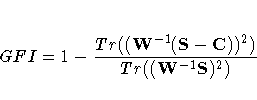
but for WLS and DWLS estimation, it is

where W = diag for DWLS estimation, and
Vec(sij - cij) denotes the vector of the n(n+1)/2
elements of the lower triangle of the symmetric matrix S- C.
For a constant weight matrix W, the goodness-of-fit
index is 1 minus the ratio of the minimum function value and the function
value before any model has been fitted.
The GFI should be between 0 and 1. The
data probably do not fit the model if the GFI
is negative or much larger than 1.
- Adjusted Goodness-of-Fit Index
The AGFI is the GFI adjusted for the
degrees of freedom of the model

The AGFI corresponds to the GFI in replacing the total sum of squares
by the mean sum of squares.
Caution:
- Large n and small df can result
in a negative AGFI. For example, GFI=0.90, n=19, and df=2
result in an AGFI of -8.5.
- AGFI is not defined for a saturated model, due to
division by df=0.
- AGFI is not sensitive to losses in df.
The AGFI should be between 0 and 1. The
data probably do not fit the model if the AGFI
is negative or much larger than 1.
For more information, refer to Mulaik et al. (1989).
- Root Mean Square Residual
The RMR is the mean of the
squared residuals:
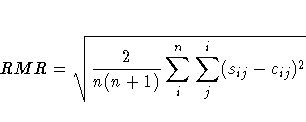
- Parsimonious Goodness-of-Fit Index
The PGFI (Mulaik et al. 1989) is
a modification of the GFI that takes the
parsimony of the model into account:

The PGFI uses the same parsimonious factor as the parsimonious
normed Bentler-Bonett index (James, Mulaik, and Brett 1982).
Goodness-of-Fit Indices Based on the 
The following items are transformations of the
overall  value and in general depend on the sample size N.
These indices are not computed for ULS or DWLS estimates.
value and in general depend on the sample size N.
These indices are not computed for ULS or DWLS estimates.
- Uncorrected

The overall  measure is the optimum
function value F multiplied by N - 1 if a CORR or COV matrix
is analyzed, or multiplied by N if a UCORR or UCOV matrix is
analyzed. This gives the likelihood
ratio test statistic for the null hypothesis that the predicted
matrix C has the specified model
structure against the alternative that C is unconstrained.
The
measure is the optimum
function value F multiplied by N - 1 if a CORR or COV matrix
is analyzed, or multiplied by N if a UCORR or UCOV matrix is
analyzed. This gives the likelihood
ratio test statistic for the null hypothesis that the predicted
matrix C has the specified model
structure against the alternative that C is unconstrained.
The  test is valid only if the observations are independent
and identically distributed, the analysis is based on the
nonstandardized sample covariance matrix S, and the sample
size N is sufficiently large (Browne 1982; Bollen 1989b;
J
test is valid only if the observations are independent
and identically distributed, the analysis is based on the
nonstandardized sample covariance matrix S, and the sample
size N is sufficiently large (Browne 1982; Bollen 1989b;
J reskog and S
reskog and S rbom 1985).
For ML and GLS estimates, the variables must also have an approximately
multivariate normal distribution.
The notation Prob>Chi**2 means "the probability
under the null hypothesis of obtaining a greater
rbom 1985).
For ML and GLS estimates, the variables must also have an approximately
multivariate normal distribution.
The notation Prob>Chi**2 means "the probability
under the null hypothesis of obtaining a greater
 statistic than that observed."
statistic than that observed."

where F is the function value at the minimum.
-
 Value of the Independence Model
Value of the Independence Model
The  value of the independence model
value of the independence model

and the corresponding degrees of freedom df0 can be used (in large samples)
to evaluate the gain of explanation by fitting the specific model
(Bentler 1989).
- RMSEA Index (Steiger and Lind 1980)
The Steiger and Lind (1980) root mean squared error approximation (RMSEA)
coefficient is
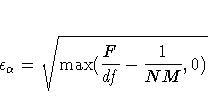
The lower and upper limits of the confidence interval
are computed using the cumulative distribution
function of the noncentral chi-squared distribution
 , with x=NM*F,
, with x=NM*F,
 satisfying
satisfying  ,and
,and  satisfying
satisfying  :
:
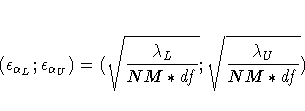
Refer to Browne and Du Toit (1992) for more details.
The size of the confidence
interval is defined by the option ALPHARMS= ,
,  .The default is
.The default is  , which corresponds to the 90% confidence interval for the RMSEA.
, which corresponds to the 90% confidence interval for the RMSEA.
- Probability for Test of Close Fit (Browne and Cudeck 1993)
The traditional exact  test hypothesis
test hypothesis  is replaced by the null hypothesis of close fit
is replaced by the null hypothesis of close fit
 and the exceedance probability P
is computed as
and the exceedance probability P
is computed as

where x=NM*F and  .The null hypothesis of close fit is rejected if P is
smaller than a prespecified level (for example, P < 0.05).
.The null hypothesis of close fit is rejected if P is
smaller than a prespecified level (for example, P < 0.05).
- Expected Cross Validation Index (Browne and Cudeck 1993)
For GLS and WLS, the estimator c of the ECVI is linearly related to AIC:

For ML estimation, cML is used.

The confidence interval (cL ; cU) for c is computed
using the cumulative distribution function  of the noncentral chi-squared distribution,
of the noncentral chi-squared distribution,

with nnt = n(n+1)/2 + t, x=NM * F,
 , and
, and
 .The confidence interval (c*L ; c*U) for cML is
.The confidence interval (c*L ; c*U) for cML is

where nnt = n(n+1)/2 + t, x=(NM-n-1) * F,
 and
and
 .Refer to Browne and Cudeck (1993).
The size of the confidence interval is defined by the option
ALPHAECV=
.Refer to Browne and Cudeck (1993).
The size of the confidence interval is defined by the option
ALPHAECV= ,
,  .The default is
.The default is  , which corresponds to the 90% confidence
interval for the ECVI.
, which corresponds to the 90% confidence
interval for the ECVI.
- Comparative Fit Index (Bentler 1989)

- Adjusted
 Value (Browne 1982)
Value (Browne 1982)
If the variables
are n-variate elliptic rather
than normal and have significant amounts of
multivariate kurtosis (leptokurtic or platykurtic), the  value
can be adjusted to
value
can be adjusted to

where  is the multivariate relative kurtosis coefficient.
is the multivariate relative kurtosis coefficient.
- Normal Theory Reweighted LS
 Value
Value
This index is
displayed only if
METHOD=ML. Instead of the function value FML, the reweighted
goodness-of-fit function FGWLS is used,

where FGWLS is the value of the function at the minimum.
- Akaike's Information Criterion (AIC)
(Akaike 1974; Akaike 1987)
This is a criterion for selecting the best model among a number of
candidate models. The model that yields the smallest value of AIC
is considered the best.

- Consistent Akaike's Information Criterion (CAIC)
(Bozdogan 1987)
This is another criterion, similar to AIC, for selecting the best
model among alternatives. The model that yields the smallest
value of CAIC is considered the best. CAIC is preferred
by some people to AIC or the  test.
test.

- Schwarz's Bayesian Criterion (SBC)
(Schwarz 1978; Sclove 1987)
This is another criterion, similar to AIC, for selecting the best
model. The model that yields the smallest value of SBC is
considered the best. SBC is preferred
by some people to AIC or the  test.
test.

- McDonald's Measure of Centrality (McDonald and Hartmann 1992)

- Parsimonious Normed Fit Index (James, Mulaik, and Brett 1982)
The PNFI is a modification of Bentler-Bonett's normed fit
index that takes parsimony of the model into account,

The PNFI uses the same parsimonious factor as the parsimonious
GFI of Mulaik et al. (1989).
- Z-Test (Wilson and Hilferty 1931)
The Z-Test of Wilson and Hilferty
assumes an n-variate normal distribution:
![Z = {{\sqrt[3]{\chi^2 \over df} - (1 - {2 \over 9 df})}
\over {\sqrt{2 \over 9 df}}}](images/caleq186.gif)
Refer to McArdle (1988) and Bishop, Fienberg, and Holland (1977, p. 527)
for an application of the Z-Test.
- Nonnormed Coefficient (Bentler and Bonett 1980)

Refer to Tucker and Lewis (1973).
- Normed Coefficient (Bentler and Bonett 1980)

Mulaik et al. (1989) recommend the parsimonious weighted form PNFI.
- Normed Index
 (Bollen 1986)
(Bollen 1986)

 is always less than or equal to 1;
is always less than or equal to 1;  is unlikely in practice.
Refer to the discussion in Bollen (1989a).
is unlikely in practice.
Refer to the discussion in Bollen (1989a).
- Nonnormed Index
 (Bollen 1989a)
(Bollen 1989a)
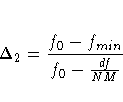
is a modification of Bentler & Bonett's  that
uses df and "lessens the dependence" on N.
Refer to the discussion in Bollen (1989b).
that
uses df and "lessens the dependence" on N.
Refer to the discussion in Bollen (1989b).
 is identical to Mulaik et al.'s (1989) IFI2 index.
is identical to Mulaik et al.'s (1989) IFI2 index.
- Critical N Index (Hoelter 1983)

where  is the critical chi-square value for the given df
degrees of freedom and probability
is the critical chi-square value for the given df
degrees of freedom and probability  , and F is the
value of the estimation criterion (minimization function). Refer to
Bollen (1989b, p. 277). Hoelter (1983) suggests that CN should be at
least 200; however, Bollen (1989b) notes that the CN value may lead
to an overly pessimistic assessment of fit for small samples.
, and F is the
value of the estimation criterion (minimization function). Refer to
Bollen (1989b, p. 277). Hoelter (1983) suggests that CN should be at
least 200; however, Bollen (1989b) notes that the CN value may lead
to an overly pessimistic assessment of fit for small samples.
Squared Multiple Correlation
The following are measures of the squared multiple
correlation for manifest and endogenous variables and are computed for
all five estimation methods: ULS, GLS,
ML, WLS, and DWLS. These coefficients
are computed as in the LISREL VI program
of J reskog and S
reskog and S rbom (1985).
The DETAE, DETSE, and
DETMV determination coefficients are intended to
be global means of the squared multiple correlations for different subsets
of model equations and variables. These coefficients are displayed only when
you specify the PDETERM option with a RAM or LINEQS model.
rbom (1985).
The DETAE, DETSE, and
DETMV determination coefficients are intended to
be global means of the squared multiple correlations for different subsets
of model equations and variables. These coefficients are displayed only when
you specify the PDETERM option with a RAM or LINEQS model.
- R2 Values Corresponding to Endogenous Variables
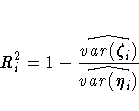
- Total Determination of All Equations
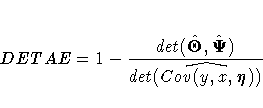
- Total Determination of the Structural Equations
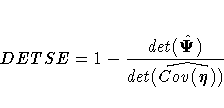
- Total Determination of the Manifest Variables
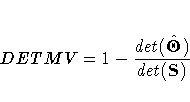
Caution: In the LISREL program, the structural equations are
defined by specifying the BETA matrix. In PROC CALIS, a structural equation
has a dependent left-hand-side variable that appears at least once
on the right-hand side of another equation, or the equation has
at least one right-hand-side variable that is the left-hand-side variable
of another equation. Therefore, PROC CALIS sometimes identifies more
equations as structural equations than the LISREL program does.
Copyright © 1999 by SAS Institute Inc., Cary, NC, USA. All rights reserved.





![]() ).
).






















![Z = {{\sqrt[3]{\chi^2 \over df} - (1 - {2 \over 9 df})}
\over {\sqrt{2 \over 9 df}}}](images/caleq186.gif)








